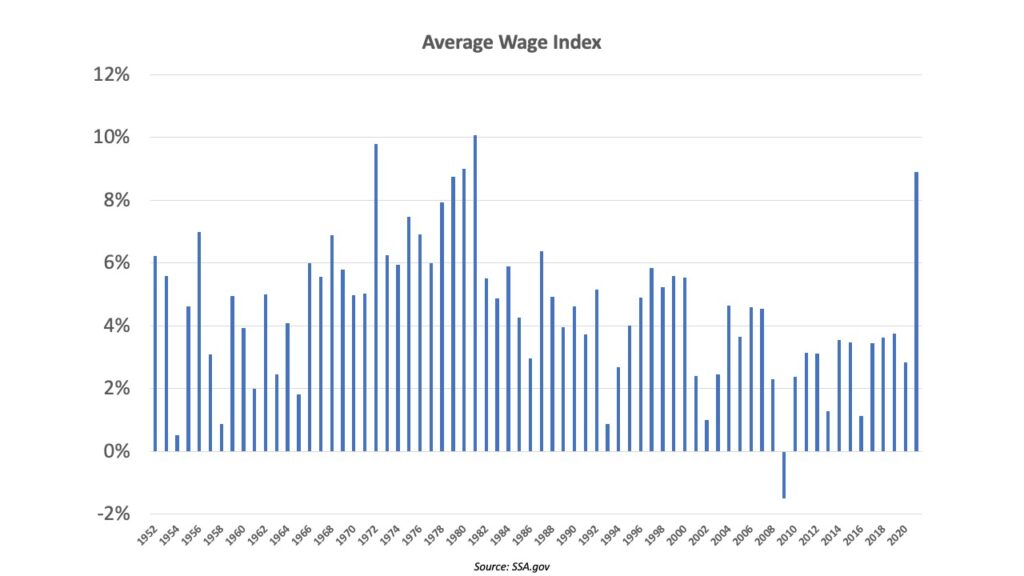
Now that we have the official announcement of all the Social Security changes for 2023, it’s time to highlight those which will be most impactful to retirees.
These changes include:
- The 2023 cost of living adjustment
- The 2023 Earnings Limit
- The amount needed to earn one credit
- The Windfall Elimination Provision (WEP) penalty
- The maximum taxable wage base
- The Substantial Gainful Activity (SGA) thresholds
For clarity, let’s examine each of these individually.
The 2023 Cost of Living Adjustment
In 2023 Social Security benefits will increase by 8.7%.
What’s unique about this year’s cost of living adjustment is that it won’t be offset by higher Part B Medicare premiums. Instead, Medicare part B premiums will be going down in 2023 from $170.10 per month to $164.90.
Changes from the Average Wage Index
While the cost of living adjustment is tied to changes in price inflation, as measured by the CPI-W, most of the annual changes to the Social Security system are tied to changes in the Average Wage Index (AWI).
The AWI is always two years behind, so the changes to the program in 2023 are based on the 2021 AWI. In 2021, the AWI increased by 8.9%. This is the fourth-highest increase to the index since 1951. With an increase of that size, the changes which are based on that index will also see a sizeable increase. 
The 2023 Earnings Limit
Prior to full retirement age, there is a limit on the amount of earnings someone can have AND collect a social security benefit. Generally, this increases every year. The limit for 2023 is going to be $21,240. The one exception is if they are in the calendar year they attain full retirement age and then the limit is $56,520.
Amount to Earn One “Credit”
To qualify for Social Security benefits from your own work, you have to have 40 credits and you can only earn up to four per year. The earnings in 2022 that qualified for one credit was $1,510 and in 2023 that is increasing to $1,640.
The Windfall Elimination Provision (WEP) Penalty
The next change is not one that affects everyone, but for those who do feels its impact, this one is important. For those turning 62 in 2023, the maximum penalty from the Windfall Elimination Provision will be $557 which is slightly higher than the $512 penalty in 2022.
Maximum Taxable Wage Cap
The maximum taxable wage cap limits the amount of wages that are subject to the Social Security portion of the FICA tax. Any earnings over the cap are not subject to the 12.4% tax (typically split 50/50 between employee and employer).
For 2022, the cap was $147,000. In 2023, that amount is increasing to $160,200.
For a W2 employee who earns at least the maximum taxable wage, this represents about an $818 tax increase.
Substantial Gainful Activity Thresholds
In order to qualify for Social Security or SSI disability, your medical condition must be severe enough to prevent you from doing more than insignificant work for at least 12 months. To determine whether a person is working too much, Social Security uses the “substantial gainful activity” (SGA) level.
Those levels for 2023 are:
- $1,470 Non-Blind
- $2,460 Blind
How You Can Level Up Your Social Security Skills
Before you leave, be sure to check out my brand new online workshop, “How To Choose The RIGHT Time To File For Social Security.”
In this workshop you’ll learn:
✔The Most Important Factors to Consider BEFORE You File for Benefits
✔How to Coordinate Your Social Security Filing Decision with Your Other Assets & Income for a Tax Efficient Distribution Strategy
✔Why This Is The Biggest Decision of Your Retirement
To access it, just click here https://www.devincarroll.com/SSessentialsonlineworkshop.

[…] cap is $147,000 in gross salary. In 2023, the limit will be $160,200. Any earnings over that cap are not subject to the Social Security portion of payroll taxes. Of the 6.2% total, 5.3% is paid into the OASI trust fund, and .9% is paid to the DI trust fund. In […]